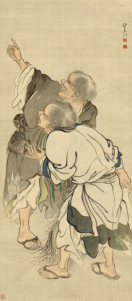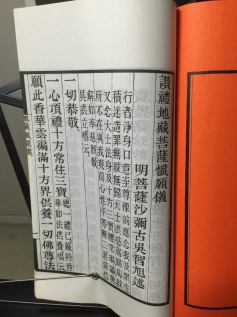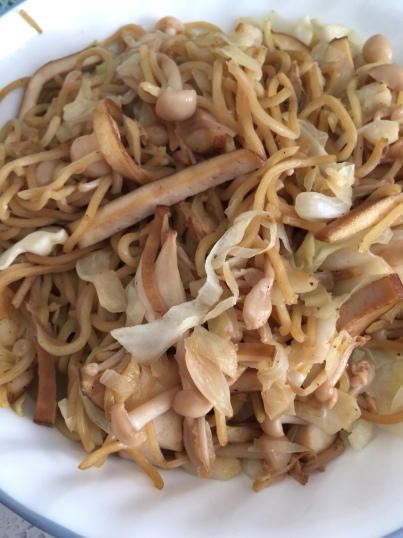 There was one time I was having an argument with one of my Dharma brothers because I accused him of stealing one of my dharma instruments. He would not admit to it and I still gave him the benefit of the doubt by trying to find it myself. By the time I gave up finding it, I still accused him of stealing it and demanding him to return it to me. I admit I have never been that angry about something like that before but that was one of those occasions where my whole precepts thing just flew out the window because I was so angry that someone I trusted would do that to me. The temple custodian later found the instrument and gave it back to me, I asked where it was and he said under the table near the main shrine, it must have rolled off the table and fell under without anyone noticing. At that moment I felt this big block of guilt on me, I took a few deep breaths after thanking the custodian and walked up to my dharma brother and humbly apologized to him and admitting that I wrongfully accused him of stealing and told him that I will be more careful before making such accusations. My dharma brother accepted my apology and he went on with his business. I on the other hand still decided to make three prostrations to the Buddha while contemplating back on the precepts and the Bodhisattva path before letting go of the incident. I did not break down or anything but I made a prayer to the Buddha and told the whole incident and the whole process and repented for what I did.
There was one time I was having an argument with one of my Dharma brothers because I accused him of stealing one of my dharma instruments. He would not admit to it and I still gave him the benefit of the doubt by trying to find it myself. By the time I gave up finding it, I still accused him of stealing it and demanding him to return it to me. I admit I have never been that angry about something like that before but that was one of those occasions where my whole precepts thing just flew out the window because I was so angry that someone I trusted would do that to me. The temple custodian later found the instrument and gave it back to me, I asked where it was and he said under the table near the main shrine, it must have rolled off the table and fell under without anyone noticing. At that moment I felt this big block of guilt on me, I took a few deep breaths after thanking the custodian and walked up to my dharma brother and humbly apologized to him and admitting that I wrongfully accused him of stealing and told him that I will be more careful before making such accusations. My dharma brother accepted my apology and he went on with his business. I on the other hand still decided to make three prostrations to the Buddha while contemplating back on the precepts and the Bodhisattva path before letting go of the incident. I did not break down or anything but I made a prayer to the Buddha and told the whole incident and the whole process and repented for what I did.
The above incident may have been a more extreme example of when I did not uphold the precepts. My Precept Master (Ven. Master Hsing Yun) gave a story about an Indian king returned to his palace from fighting a war and was unhappy with the meal he had so he ordered to have the royal chef executed. The Queen, who was upholding the precepts at the time, wanted to save the royal chef’s life, so she invited the king to have a drink and requested an appetizer that only the royal chef knew how to prepare. The king then realized that he just ordered for him to be executed and immediately ordered for him to be released, thus the queen successfully saved the royal chef’s life. The queen violated the precept of consuming an intoxicant but that was her application of skillful means to save a life. I think this is more like bending the precepts instead of breaking or defiling them because I feel like even though an unwholesome act was committed, the intention/mindset behind the action is more important so this may not necessarily mean that the precept is broken. One experience I constantly have is with insects around my house. Recently I found a wasp’s nest above my porch, there were still wasps swarming back and forth near my main entrance. I did not know how to get rid of them since I was afraid that if I got stung I could get skin complications, and for the sake of my mother and young nephews, I had to seek professional help. I called someone in and he sprayed some pesticide and at the same time in my mind, I was apologizing to the wasps. That evening after everything got cleaned up, I did a smoke offering puja and dedicated the merit to the wasps that were lost.

 Han Shan, or Cold Mountain was a legendary figure around the Tang Dynasty that was associated with a collection of poetry used by Zen, or Chan, Buddhists and Daoists alike. He didn’t really keep to conventional tactics of paper, brush, and ink. He carved on bamboo, wrote on walls, rocks, mountains, etc. He is often depicted with Shi-de, the pair is always known as Han Shan Shi De. Some believed that they were manifestations of Manjusri Bodhisattva and Samantabhadra Bodhisattva. There were no clear dates, or even a given name about Cold Mountain, but the common understanding so far was that he was around sometime during the eighth and ninth centuries. Most of his footprints were around the Tien Tai Mountains of the area south of Hangzhou. Many of his works were written near the area. He wrote about 600 piece of poetry, of which 313 pieces were collected till this day. The content of his works mainly revolve around his experiences or encounters he has had with people he met or even his thoughts about society. His works can be of simple observation, natural or social, but can definitely transcend what seem to be mundane facts into ultimate truths. That was how Zen Cold Mountain was. For this reason, and the attractiveness of overall biographical mystery, countless poets, scholars, misfits and Zen practitioners today count themselves amongst the devoted. He never wrote by traditional brush and paper though. He carved on the walls of the caved he lived in, the trunks of surrounding trees, bamboo husks, etc. For this paper I will quote one of Cold Mountain’s poetry and share my reflections along with commentary from current Masters.
Han Shan, or Cold Mountain was a legendary figure around the Tang Dynasty that was associated with a collection of poetry used by Zen, or Chan, Buddhists and Daoists alike. He didn’t really keep to conventional tactics of paper, brush, and ink. He carved on bamboo, wrote on walls, rocks, mountains, etc. He is often depicted with Shi-de, the pair is always known as Han Shan Shi De. Some believed that they were manifestations of Manjusri Bodhisattva and Samantabhadra Bodhisattva. There were no clear dates, or even a given name about Cold Mountain, but the common understanding so far was that he was around sometime during the eighth and ninth centuries. Most of his footprints were around the Tien Tai Mountains of the area south of Hangzhou. Many of his works were written near the area. He wrote about 600 piece of poetry, of which 313 pieces were collected till this day. The content of his works mainly revolve around his experiences or encounters he has had with people he met or even his thoughts about society. His works can be of simple observation, natural or social, but can definitely transcend what seem to be mundane facts into ultimate truths. That was how Zen Cold Mountain was. For this reason, and the attractiveness of overall biographical mystery, countless poets, scholars, misfits and Zen practitioners today count themselves amongst the devoted. He never wrote by traditional brush and paper though. He carved on the walls of the caved he lived in, the trunks of surrounding trees, bamboo husks, etc. For this paper I will quote one of Cold Mountain’s poetry and share my reflections along with commentary from current Masters. There have been more than a few occasions where someone will have an issue and after consulting with a monastic or a minister, that person has prescribed to do a certain number of recitations and meditate for x times per day at whatever minutes per session. After performing all those actions, the problem never seemed to go away in the first place, if not ferment into something worse.
There have been more than a few occasions where someone will have an issue and after consulting with a monastic or a minister, that person has prescribed to do a certain number of recitations and meditate for x times per day at whatever minutes per session. After performing all those actions, the problem never seemed to go away in the first place, if not ferment into something worse.





 I still try to find time to cook whenever possible. It is true that after my work at the temple the volunteers offer me a bento or food I can take back home to warm up for dinner, but that’s not always the case. On nights when I don’t feel like making a three-course meal but would still like to cook something from scratch, chow mein has been my go-to dish to make. It’s a good potluck dish for a party as well.
I still try to find time to cook whenever possible. It is true that after my work at the temple the volunteers offer me a bento or food I can take back home to warm up for dinner, but that’s not always the case. On nights when I don’t feel like making a three-course meal but would still like to cook something from scratch, chow mein has been my go-to dish to make. It’s a good potluck dish for a party as well.